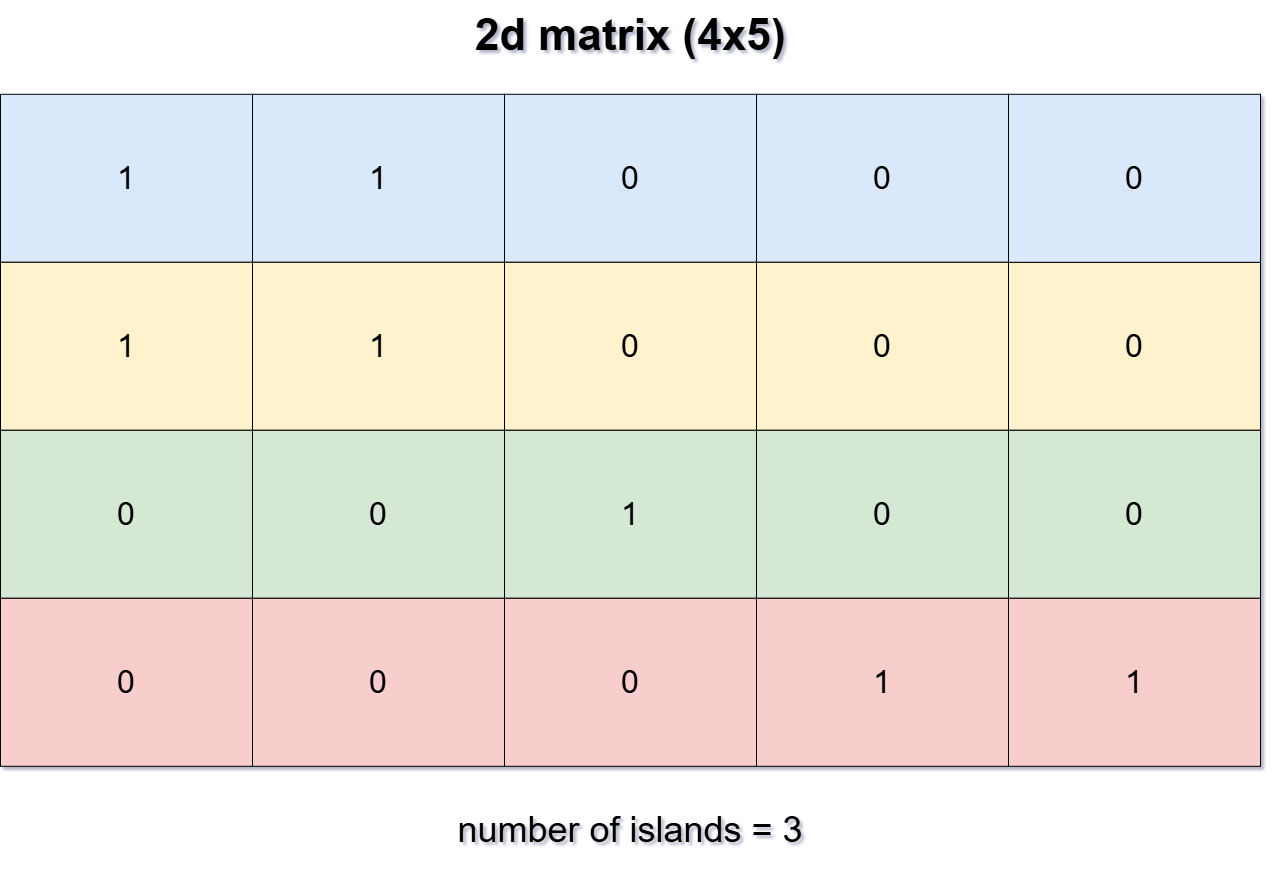Calculate the number of islands in a 2D grid
Calculate the number of islands in a 2D grid using Breadth-First Search (BFS).

- Created:
- Updated:
- Tags:
- #algorithms #breadth-first-search #data-structures #queue
Problem statement
Given an m x n 2D binary grid which represents a map of ‘1’s (land) and ‘0’s (water), return the number of islands.
An island is surrounded by water and is formed by connecting adjacent land cells horizontally or vertically. You may assume all four edges of the grid are all surrounded by water.
Constraints:
m == grid.length
n == grid[i].length
1 <= m, n <= 300
grid[i][j] is '0' or '1'.Solution
To solve this problem we need to loop through the two-dimensional array, and perform a Breadth-First Search on each land, increasing the number of islands counter. In the BFS we are going to search and mark as visited all the adjacent nodes, vertically or horizontally so they can be considered as part of the same island. Once there are no more adjacent land cells, start again until we have traversed the entire grid. As usual, it can be resolved iteratively or recursively. In this post we are going to focus on the iterative version.
Introduction
We will need:
- A queue to store the indices (row and column) as a number that we are going to visit using the BFS algorithm
- An integer to represent the counter of the number of islands
Step 1
Loop through each element of the array starting from i=0, j=0
Step 2
If we find a ‘1’ land:
- Increment number of islands counter
- Mark as visited by modifying the grid value to water ‘0’
- Enqueue the current node index by the formula
row * NUMBER_OF_COLUMNS + column. We will parse this index later like this:- row:
Math.floor(index / NUMBER_OF_COLUMNS) - column:
index % NUMBER_OF_COLUMNS
- row:
Step 3
If the queue is not empty, perform a Breadth-First Search
- Search adjacent nodes in all four directions (bottom, right, left, top):
- Right:
(row, column + 1) - Bottom:
(row + 1, column) - Left:
(row, column - 1) - Top:
(row - 1, column)
For each adjacent node:
- Verify it’s within grid boundaries
- Verify it’s land (‘1’), not water (‘0’)
-
If we detect land ‘1’, mark as visited by changing the value to water ‘0’ and enqueue this node index
-
At the end of the iteration, dequeue the head
Run BFS iteratively, adding the index to the queue and marking as visited until the queue is empty, with this approach we will mark all the adjacent land cells as visited for the current island. Once we finish the BFS, we go back to step 1 and continue traversing the grid until we find another land ‘1’ to start a new island count.
Code
import { Queue } from '../queue';
/*
Assume that you have a Queue like this one:
export interface Queue<T> {
constructor(maxSizeOfQueue: number)
enqueue(value: T): boolean
dequeue(): boolean
front(): T | null
rear(): T | null
isEmpty(): boolean
isFull(): boolean
size(): number
}
*/
export function numIslands(grid: string[][]): number {
// introduction
const ROWS = grid.length;
if (ROWS === 0) {
return 0;
}
const COLUMNS = grid[0].length;
const queue = new Queue<number>(COLUMNS * ROWS);
let numberOfIslands = 0;
// step 1: loop through the matrix
for (let i = 0; i < ROWS; i++) {
for (let j = 0; j < COLUMNS; j++) {
// step 2: find '1's lands
const currentValue = grid[i][j];
if (currentValue !== '1') continue;
numberOfIslands++;
queue.enqueue(i * COLUMNS + j);
grid[i][j] = '0';
const fill = (row: number, column: number) => {
if (
row >= ROWS ||
column >= COLUMNS ||
row < 0 ||
column < 0 ||
grid[row][column] === '0'
) {
return;
}
queue.enqueue(row * COLUMNS + column);
grid[row][column] = '0';
};
// step 3: BFS algorithm
while (!queue.isEmpty()) {
const node = queue.front()!;
const row = Math.floor(node / COLUMNS);
const column = node % COLUMNS;
// search adjacent nodes
fill(row, column + 1); // right
fill(row + 1, column); // bottom
fill(row, column - 1); // left
fill(row - 1, column); // top
queue.dequeue();
}
}
}
return numberOfIslands;
}Complexity analysis
- Time complexity: O(n), where n is the
rows * columns, so the number of cells in the grid - Space complexity: O(n), where n is the number of cells in the grid



